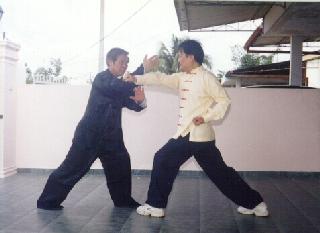TAI CHI CHUAN AND TAI CHI DANCE

Tai Chi Chuan
Question
Please tell me your views on the combat part of Tai Chi Quan.
-- Gurmeet, UK
Answer
Tai Chi Chuan (Tai Chi Quan), or Taijiquan in Romanized Chinese, is an internal martial art. There is no doubt about this fact, and it can be easily verified. The term “Tai Chi Chuan” (Taijiquan) is a shortened form of “Tai Chi Chuan Fa” (Taiji-quanfa), which in Chinese, word by word, means “Grand Ultimate Martial Art.” If you examine Tai Chi Chuan classics written in Chinese by past masters, all of them without a single exception treat it as a martial art.
The trouble is that most people today, including in China, do not practise Tai Chi Chuan as a martial art; they practise it as a gentle exercise, sometimes with music accompaniment. This is because during a few generations of its transmission in the last 50 or so years, its martial aspect was lost.
How did this happen? Practising Tai Chi Chuan as a martial art needed much time and effort. Students had to perfect their forms. This itself took a few years. Besides, they had to develop internal force and practise combat application. This demanded much effort and endurance. Most students had neither patience nor endurance, but some of them were impatient to become masters themselves without first becoming good students.
So, without their masters' approval, they started to teach others, often in public parks and without charging fees. Then their students taught other students and the trend continued to the present day when it has become a norm. A similar development is happening now in chi kung. Many people who know some external chi kung forms, but know nothing about energy management, are impatient to teach others.
Indeed anyone with some knowledge of how Tai Chi Chuan was taught and practised in the past, where the art was kept as top secret and masters might not teach even students paid them a lot of money, would immediately see the incongruence of people teaching Tai Chi publicly and for free or for a nominal fee. The situation has degraded so ridiculously that some modern Tai Chi instructors have to appease their students to attract them to learn, and some students consider it doing their instructors a favour by learning.
What these instructors teach is only forms; they themselves do not have internal force or know combat application. Their students are like them, not because the lessons are cheap but because the lessons are enjoyable and easy, and it is very different from the demanding training of genuine Tai Chi Chuan in the past.
These Tai Chi instructors and their students are also usually gentle, friendly persons, quite unlike many instructors and students of other martial arts who are often rough and aggressive. If they have taught for some time, the ignorant public call them masters. Some of these masters publish books, usually called Tai Chi (not Tai Chi Chuan) and usually in English, and almost always these books merely show how to perform the external forms of Tai Chi Chuan, usually illustrated with photographs.
These teachers and practitioners of degraded Tai Chi are generally nice people, and they fulfil important functions of socialization and recreation. But my views are different. As I have always regarded Tai Chi Chuan as an internal martial art, I regard its combat part essential. Without combat efficiency as well as internal force, the art degrades into a gentle exercise or a dance.
The combat dimension of Tai Chi Chuan is not only effective, but superior to that of most other martial arts. Its superiority lies not just in techniques but also in all other aspects of combat, including the nature of force, use of tactics and strategies, and relation to health — aspects that most other martial arts do not seem to consider.
Regarding techniques, many other martial arts are limited in their range. A judo exponent, for example, is limited in his defence against kicks, and a taekwondo exponent limited against throws, whereas a Tai Chi Chuan exponent (but not a Tai Chi dancer) is trained to handle all types of attacks.
Most other martial arts mainly use mechanical strength, whereas Tai Chi Chuan uses internal force which has more scope and depth. Most other arts pay little or no attention to tactics and strategies, as evident in the free exchange of blows which is normal in their fighting. Skilful use of tactics and strategies is crucial in Tai Chi Chuan, as evident in such Tai Chi Chuan tenets like “exploiting the opponent's strength against himself” and “starting later but arriving earlier”.
Most other martial arts are actually detrimental to health. The training methods often over-burden the internal organs of the practitioners, and injuries sustained are routinely left untreated. On the other hand, Tai Chi Chuan promotes health. Tai Chi Chuan training ensures the exponents to be calm and relaxed, generate their energy flow, and strengthen internal organs.
If you wish to learn Tai Chi Chuan combat, obviously you have to learn from someone who knows Tai Chi Chuan combat. If you learn from one who teaches only Tai Chi forms, you will only know how to perform Tai Chi form.
The above is taken from Question 10 Feb 2000 Part 3 of the Selection of Questions and Answers.
LINKS
Courses and Classes
